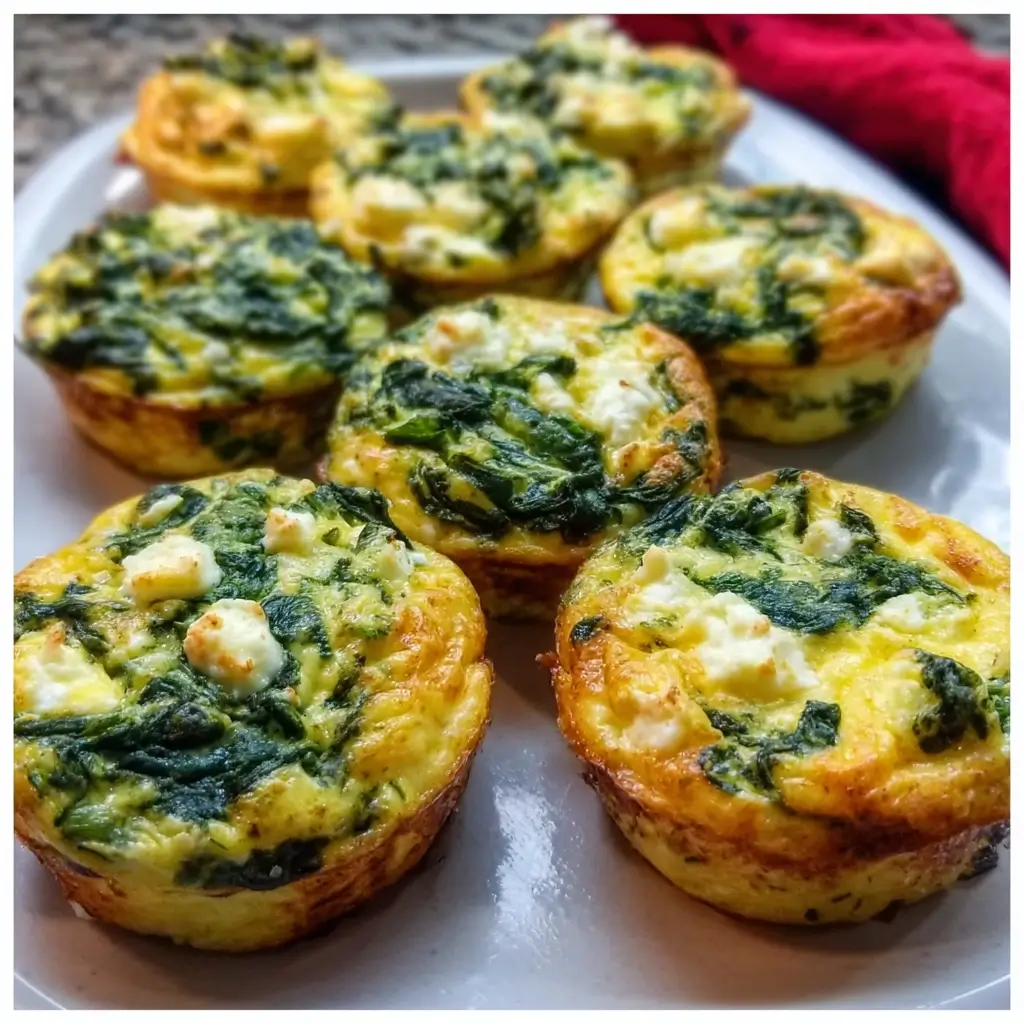Of all the meal-prep recipes I’ve tried over the years, these Spinach Feta Egg Muffins hold a special place in my heart and my weekly routine. The first time I made them, I was desperately seeking a solution to the chaotic weekday morning rush. Getting myself and the kids ready and out the door felt like a marathon, and breakfast was often an afterthought—usually a sugary cereal bar or a piece of toast grabbed on the way out. I wanted something better, something packed with protein that would actually keep us full and focused until lunchtime. When I pulled the first batch of these savory muffins from the oven, the aroma of baked eggs, savory spinach, and tangy feta filled the kitchen, and I had a feeling I was onto something. My husband, initially skeptical of a “muffin” without sugar, took one bite and was instantly converted. The kids, who normally turn their noses up at anything green, devoured them, calling them “cheesy egg bites.” It was a total victory. Now, making a double batch on a Sunday afternoon has become a ritual. They are the ultimate grab-and-go breakfast, a quick and satisfying snack, and a lifesaver on those mornings when everything seems to go wrong. They are fluffy, flavorful, and endlessly customizable, proving that a healthy breakfast doesn’t have to be complicated or boring.
Ingredients for Perfect Spinach Feta Egg Muffins
Here is everything you need to create these delicious and protein-packed breakfast bites. Using fresh, quality ingredients will make a noticeable difference in the final flavor and texture.
- Large Eggs (12): The star of the show. Twelve large eggs form the protein-rich, fluffy base of our muffins, providing structure and essential nutrients.
- Fresh Spinach (5 oz / 140g): A generous portion of fresh spinach not only adds a beautiful green color but also packs in vitamins and minerals. We will wilt it first to remove excess water.
- Crumbled Feta Cheese (1 cup / 150g): This provides the signature salty, tangy flavor that makes these muffins so irresistible. Use a block of feta and crumble it yourself for the best texture.
- Milk or Unsweetened Almond Milk (1/4 cup / 60ml): A small amount of milk adds creaminess and helps create a softer, more tender crumb. You can use any milk of your choice.
- Yellow Onion (1/2, finely chopped): Adds a foundational layer of sweet and savory flavor that complements the other ingredients perfectly.
- Garlic (2 cloves, minced): Provides a pungent, aromatic kick that elevates the overall taste profile.
- Olive Oil (1 tbsp): Used for sautéing the onion, garlic, and spinach, bringing out their flavors before they are mixed into the eggs.
- Black Pepper (1/2 tsp, freshly ground): Adds a gentle heat and spice. Freshly ground pepper offers the most robust flavor.
- Salt (1/4 tsp): Just a small amount is needed, as the feta cheese is already quite salty. Adjust to your personal taste.
- Optional: Red Pepper Flakes (1/4 tsp): For those who enjoy a little bit of heat, a pinch of red pepper flakes adds a wonderful warmth.
Step-by-Step Instructions
Follow these detailed instructions to ensure your egg muffins come out perfectly fluffy, flavorful, and never watery. The key is in the preparation of the vegetables before they meet the eggs.
- Preheat and Prepare: First, preheat your oven to 375°F (190°C). Thoroughly grease a 12-cup standard muffin tin with non-stick cooking spray, olive oil, or butter. Alternatively, you can use silicone muffin liners, which are excellent for preventing sticking.
- Sauté the Aromatics: Heat the olive oil in a medium-sized skillet or pan over medium heat. Add the finely chopped onion and sauté for 3-4 minutes until it becomes soft and translucent. Add the minced garlic and cook for another minute until fragrant, being careful not to let it burn.
- Wilt the Spinach: Add the fresh spinach to the skillet in batches. It will look like a lot, but it wilts down significantly. Stir continuously until all the spinach has wilted, which should take about 2-3 minutes.
- The Most Important Step – Squeeze the Spinach: Transfer the cooked spinach and onion mixture to a fine-mesh sieve or a colander. Using the back of a spoon or a spatula, press down firmly on the mixture to squeeze out as much excess liquid as possible. This step is crucial to prevent your egg muffins from becoming watery and spongy. You will be surprised by how much water comes out. Set the squeezed mixture aside to cool slightly.
- Whisk the Eggs: In a large mixing bowl, crack all 12 eggs. Add the milk, salt, black pepper, and optional red pepper flakes. Whisk vigorously until the yolks and whites are completely combined and the mixture is light and slightly frothy. A good whisking incorporates air, which helps make the muffins fluffy.
- Combine the Ingredients: Once the spinach mixture has cooled down a bit (so it doesn’t scramble the eggs), add it to the whisked eggs. Add the crumbled feta cheese as well. Gently stir everything together until all the ingredients are evenly distributed throughout the egg mixture.
- Fill the Muffin Cups: Carefully pour or ladle the egg mixture into the prepared muffin tin, filling each cup about three-quarters of the way full. Do not overfill, as the eggs will puff up significantly while baking.
- Bake to Perfection: Place the muffin tin in the preheated oven and bake for 20-25 minutes. The muffins are done when they are puffed up, golden brown around the edges, and a toothpick or knife inserted into the center of a muffin comes out clean.
- Cool and Serve: Remove the muffin tin from the oven. Let the egg muffins cool in the tin for at least 5-10 minutes. This allows them to set further and makes them much easier to remove. To remove, gently run a thin knife or spatula around the edge of each muffin. Enjoy them warm or let them cool completely for storage.
Nutrition Facts
This recipe yields 12 standard-sized muffins. The nutritional information is an estimate for one muffin.
- Servings: 12 Muffins
- Calories per serving: Approximately 110 kcal
- Protein (9g): An excellent source of high-quality protein, which is vital for muscle maintenance, satiety, and providing sustained energy, making these muffins a perfect breakfast to keep you full and focused.
- Carbohydrates (2g): With very few carbs, these egg muffins are a fantastic option for those following a low-carb or ketogenic lifestyle.
- Fat (7g): Contains healthy fats from the eggs and olive oil, which are important for brain function and hormone production.
- Sodium (320mg): The majority of the sodium comes from the feta cheese. If you are monitoring your sodium intake, you can use a lower-sodium feta or reduce the amount used.
- Vitamin K (75% of DV): Spinach is a powerhouse of Vitamin K, an essential nutrient for blood clotting and bone health.
Preparation Time
These muffins are designed for efficiency without sacrificing flavor, making them ideal for meal prep.
- Prep Time: 15 minutes
- Cook Time: 25 minutes
- Total Time: 40 minutes
The total time of 40 minutes includes chopping the vegetables, sautéing, whisking the eggs, and baking. The active preparation time is minimal, and while they bake, you are free to prepare other things. Once you have made them a few times, you will find the process becomes even quicker.
How to Serve Your Delicious Egg Muffins
These Spinach Feta Egg Muffins are incredibly versatile. They can be served warm, at room temperature, or even cold, making them suitable for a variety of meals and occasions.
For a Quick On-the-Go Breakfast
- Simply grab one or two muffins straight from the refrigerator as you head out the door.
- For a warm breakfast on the run, wrap a muffin in a paper towel and microwave for 20-30 seconds.
- Pair with a piece of fruit like an apple or a banana for a more balanced and portable meal.
For a Balanced Brunch Plate
Create a beautiful and satisfying brunch or lunch by serving the egg muffins as the centerpiece.
- With Freshness: Serve two muffins alongside a handful of fresh arugula or a simple side salad dressed with lemon vinaigrette.
- With Creaminess: Add a side of sliced avocado, sprinkled with a little salt and chili flakes.
- With a Kick: A dollop of your favorite salsa, pico de gallo, or a smear of spicy aioli on the side adds a burst of flavor.
- With Grains: For a heartier meal, serve with a slice of whole-grain toast or a side of roasted sweet potatoes.
For a Kid-Friendly Meal
- Serve them with a side of ketchup or a mild yogurt-based dip for dunking.
- Pair with cherry tomatoes, cucumber slices, and a small container of berries for a healthy lunchbox meal.
- Cut them into smaller, bite-sized pieces for toddlers.
Additional Tips for Egg Muffin Perfection
Unlock the full potential of your spinach feta egg muffins with these eight expert tips. These small adjustments can make a big difference in texture, flavor, and convenience.
- Don’t Dare Skip Squeezing the Spinach: This tip is so important it’s worth repeating. Excess water from spinach is the number one cause of soggy, spongy, and sad egg muffins. After wilting, place the spinach in a sieve and press down firmly with a spoon. For maximum water removal, let it cool slightly and then use your hands to squeeze out every last drop.
- Grease Your Pan Generously (Or Use Liners): Eggs have a tendency to stick. To ensure your muffins pop out cleanly, be very liberal with your non-stick spray or butter. A silicone muffin pan is a fantastic investment if you plan to make these regularly, as they are naturally non-stick. Silicone liners also work wonders in a traditional metal pan.
- The Cooling Period is Non-Negotiable: Don’t try to remove the muffins from the tin the second they come out of the oven. As they cool, they will firm up and naturally pull away from the sides of the pan. A 5-10 minute cooling time will save you the frustration of broken muffins.
- Master Your Storage and Reheating Game: For refrigeration, store the completely cooled muffins in an airtight container for up to 4-5 days. To freeze, place the cooled muffins on a baking sheet in a single layer and freeze for an hour. Then, transfer them to a zip-top freezer bag. This prevents them from sticking together. To reheat, microwave for 30-45 seconds or, for a better texture, use an air fryer or toaster oven at 350°F (175°C) for 5-7 minutes until heated through.
- Don’t Overbake: Overbaking can lead to a rubbery texture. Keep a close eye on them towards the end of the cooking time. The muffins should be puffed and set in the center. A slight jiggle is okay, as they will continue to cook from residual heat after being removed from the oven.
- Embrace Variations and Customizations: This recipe is a fantastic base for creativity.
- Cheeses: Swap feta for goat cheese, sharp cheddar, Monterey Jack, or Swiss.
- Vegetables: Add finely diced bell peppers, mushrooms, zucchini (squeezed of moisture), or sun-dried tomatoes.
- Protein: For a meatier version, add cooked and crumbled bacon, sausage, or diced ham.
- Herbs: Fresh dill, chives, or parsley can add another layer of freshness and complexity.
- Achieve Maximum Fluffiness: For the fluffiest possible texture, a few small tricks can help. Ensure your eggs are at room temperature before you begin. When you whisk the eggs and milk, do so for a full minute to incorporate plenty of air. Some recipes even call for a tiny pinch (1/8 teaspoon) of baking powder to provide extra lift.
- Mind the Salt: Feta cheese is naturally very salty. It’s best to add the small amount of salt called for in the recipe, taste the egg mixture before baking (if you’re comfortable doing so), and then decide if it needs more. You can always add a sprinkle of flaky sea salt upon serving if needed.
Frequently Asked Questions (FAQ)
Here are answers to some of the most common questions about making Spinach Feta Egg Muffins.
1. Why are my egg muffins watery or spongy?
This is almost always due to excess moisture from the vegetables. It is absolutely critical to sauté your spinach and onions and then squeeze out as much liquid as possible before adding them to the egg mixture. If you add other high-water-content vegetables like mushrooms or zucchini, they must also be cooked and drained first.
2. Can I make these dairy-free?
Yes, you can easily make this recipe dairy-free. Simply substitute the regular milk with an equal amount of unsweetened almond milk, soy milk, or oat milk. For the cheese, you can use a dairy-free feta alternative or simply omit it and add more vegetables and perhaps a teaspoon of nutritional yeast for a “cheesy” flavor.
3. How long do spinach feta egg muffins last in the fridge?
When stored properly in an airtight container, these egg muffins will stay fresh and delicious in the refrigerator for up to 5 days. This makes them the perfect candidate for Sunday meal prep to have on hand for the entire work week.
4. Can I freeze these egg muffins?
Absolutely! They freeze beautifully. First, allow the muffins to cool completely to room temperature. To prevent them from sticking together, place them on a baking sheet in a single layer and “flash freeze” them for about 1-2 hours. Once solid, transfer them to a freezer-safe zip-top bag or container. They can be stored in the freezer for up to 3 months.
5. My egg muffins are sticking to the pan. What did I do wrong?
Sticking is usually caused by one of two things: insufficient greasing or not letting them cool long enough. Be sure to coat every part of the muffin cup with a non-stick spray or fat. If you’re still having trouble, silicone liners or a silicone pan are the best solutions. Additionally, letting the muffins cool in the pan for at least 5-10 minutes is crucial for an easy release.
6. Can I use an alternative to spinach?
Yes, this recipe is very forgiving. You can substitute spinach with an equal amount of finely chopped kale (stems removed), Swiss chard, or a combination of other vegetables like diced bell peppers, broccoli florets (steamed and chopped), or sun-dried tomatoes. Just remember the golden rule: cook down and drain any vegetable with high water content.
7. Are these egg muffins keto-friendly?
Yes, these Spinach Feta Egg Muffins are an excellent choice for anyone on a ketogenic diet. They are naturally high in protein and healthy fats while being very low in carbohydrates (approximately 2g net carbs per muffin). They provide a satisfying and nutrient-dense meal that aligns perfectly with keto principles.
8. Why did my egg muffins deflate after baking?
It is completely normal for egg muffins to puff up dramatically in the oven and then deflate slightly as they cool. This happens as the steam that caused them to rise escapes. While you can’t prevent it entirely, you can minimize it by not over-whisking the eggs (a good whisk is fine, but don’t beat them for minutes on end) and avoiding opening the oven door while they bake. Rest assured, even if they deflate a bit, they will still be incredibly delicious and fluffy on the inside.






